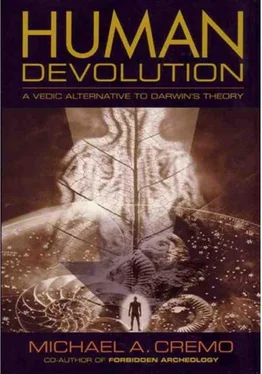Michael Cremo - Human Devolution - A Vedic Alternative To Darwin's Theory
Здесь есть возможность читать онлайн «Michael Cremo - Human Devolution - A Vedic Alternative To Darwin's Theory» весь текст электронной книги совершенно бесплатно (целиком полную версию без сокращений). В некоторых случаях можно слушать аудио, скачать через торрент в формате fb2 и присутствует краткое содержание. Год выпуска: 2003, ISBN: 2003, Издательство: Torchlight Publishing, Жанр: Старинная литература, на английском языке. Описание произведения, (предисловие) а так же отзывы посетителей доступны на портале библиотеки ЛибКат.
- Название:Human Devolution: A Vedic Alternative To Darwin's Theory
- Автор:
- Издательство:Torchlight Publishing
- Жанр:
- Год:2003
- ISBN:9780892133345
- Рейтинг книги:4 / 5. Голосов: 1
-
Избранное:Добавить в избранное
- Отзывы:
-
Ваша оценка:
- 80
- 1
- 2
- 3
- 4
- 5
Human Devolution: A Vedic Alternative To Darwin's Theory: краткое содержание, описание и аннотация
Предлагаем к чтению аннотацию, описание, краткое содержание или предисловие (зависит от того, что написал сам автор книги «Human Devolution: A Vedic Alternative To Darwin's Theory»). Если вы не нашли необходимую информацию о книге — напишите в комментариях, мы постараемся отыскать её.
Human Devolution: A Vedic Alternative To Darwin's Theory — читать онлайн бесплатно полную книгу (весь текст) целиком
Ниже представлен текст книги, разбитый по страницам. Система сохранения места последней прочитанной страницы, позволяет с удобством читать онлайн бесплатно книгу «Human Devolution: A Vedic Alternative To Darwin's Theory», без необходимости каждый раз заново искать на чём Вы остановились. Поставьте закладку, и сможете в любой момент перейти на страницу, на которой закончили чтение.
Интервал:
Закладка:
Since the subtle sense is material, it may be able to act upon gross physical matter, without going through the related physical sense organ. This model may therefore explain some of the phenomena reported in connection with ghosts and apparitions, and in connection with mediums, particularly the mysterious movement of physical objects.This model may also explain how persons are able to experience sense data during near death experiences, during which the physical sense organs are incapacitated because of anesthesia or shock.
The subtle senses are compared to attendants of the Queen. They serve her by bringing information and by conducting activity. Together they comprise the array of material intelligence and sensory capabilities, all formed from subtle but nevertheless material energy. In combination, they manufacture a self picture, with which the King becomes entranced and falsely identifies. The body itself, the City of Nine Gates, is made of gross material energy, of the kind that can be manipulated by ordinary physics and chemistry. It is powered by five subtle airs, listed in the Ayur Veda, the Vedic medical science, as prana, apana, vyana, samana, and udana . In the Puranjana allegory the five airs, comprising the vital force, are represented by a five-headed serpent.
In the allegory, Puranjana asks about the identity and origin of the Queen and her attendants. The Queen replies, “O best of human beings, I do not know who has begotten me. I cannot speak to you perfectly about this. Nor do I know the names or the origins of the associates with me. O great hero, we only know that we are existing in this place. We do not know what will come after. Indeed, we are so foolish that we do not care to understand who has created this beautiful place for our residence. My dear gentleman, all these men and women with me are known as my friends, and the snake, who always remains awake, protects this city even during my sleeping hours. So much I know. I do not know anything beyond this. You have somehow or other come here. This is certainly a great fortune for me. I wish all auspicious things for you. You have a great desire to satisfy your senses, and all my friends and I shall try our best in all respects to fulfill your desires. I have just arranged this city of nine gates for you so that you can have all kinds of sense gratification. You may live here for one hundred years, and everything for your sense gratification will be supplied.”
The King’s questioning the Queen represents the self’s interrogation of material intelligence for the answers to ultimate questions. The answers provided by the Queen, as well as her fundamental attitude, reflect those of modern science, which prides itself on avoidance of certain metaphysical questions and the tentativeness of whatever answers it may provide to other questions. “I cannot speak to you perfectly about this. . . . We only know that we are existing in this place.” Essentially, the Queen provides a monist, materialist answer to the King’s questions about his situation.
The Shrimad Bhagavatam then provides a more detailed description of the nine gates of the city inhabited by the King and Queen. Seven of the gates are on the surface (the two eyes, two ears, two nostrils, and mouth), and two of the gates are subterranean (the anus and genitals). Five of the gates face east.
The first two gates on the eastern side are called Khadyota (glowworm) and Avirmukhi (torchlight). In order to see, the King would exit these two gates, and go to the city called Vibhrajita (clear vision). On this journey he would be accompanied by his friend Dyuman (the sun, the ruler of the subtle visual sense).
In other words, the King encounters qualia by sensory contact through the physical gates of the body. Qualia are secondary properties of objects, such as color. In consciousness studies, the question of how we perceive qualia is a much debated topic. Do they exist in their own right, in the objects with which they are identified, or do they exist only in our own minds? According to the Shrimad Bhagavatam system, qualia, such as colors, exist as subtle sense objects. They thus have a reality of their own, and are not simply produced within the mind. The five subtle sense objects are sight, sound, taste, smell, and touch.
That the King goes out through the gates of the eyes to contact subtle sense objects in a city of visual impressions is interesting. This suggests that the seeing process is not simply one of passive reception, but may involve an active process of image acquisition (as in sonar, or radar). This may explain such phenomena as traveling clairvoyance, whereby a subject can mentally journey to a particular location, beyond the range of the physical sense organs, and then accurately report visual impressions. Visual sensations reported during out of body experiences could also be explained by this model. The exact relationships between the physical sense organs, the subtle senses, and subtle sense objects are not easily understood, but could perhaps be clarified by experimental work based on the overall model of the City of Nine Gates.
In the eastern part of King Puranjana’s city there are, in addition to the eyes, two gates called Nalini and Naalini, representing the nostrils. The King would go through these two gates with a friend called Avadhuta (representing breathing airs) to the town of Saurbha (odor). The last gate on the eastern side is Mukhya (the mouth), through which the King would go with two friends to the towns of taste sensation and nourishment.
Through the two gates on the northern and southern sides (the ears), the King would go to places where different kinds of sound were heard. Through the gates on the western side of the city, the King would go to the towns where sensations of sexual pleasure and evacuation are experienced. During his journeys, the King would take help from two blind men, Nirvak and Peshakrit, who represent the arms and legs.
In all his activities, the King would follow the lead of the Queen. In other words, the conscious self in the material world becomes conditioned by material intelligence. The Shrimad Bhagavatam says: “When the Queen drank liquor, King Puranjana also engaged in drinking. When the Queen dined, he used to dine with her, and when she chewed, King Puranjana used to chew along with her. When the Queen sang, he also sang, and when the Queen laughed, he also laughed. When the Queen talked loosely, he also talked loosely, and when the Queen walked, the King walked behind her. When the Queen would stand still, the King would also stand still, and when the Queen would lie down in bed, he would also follow and lie down with her. When the Queen sat, he would also sit, and when the Queen heard something, he would follow her to hear the same thing. When the Queen saw something, the King would also look at it, and when the Queen smelled something, the King would follow her to smell the same thing. When the Queen touched something, the King would also touch it, and when the dear Queen was lamenting, the poor King also had to follow her in lamentation. In the same way, when the Queen felt enjoyment, he also enjoyed, and when the Queen was satisfied, the King also felt satisfaction.”
As noted above, an important question that arises concerning dualist solutions to the mind/body question is how a nonmaterial conscious mind interacts with material sense objects. In this model, there is an answer to this question. The interaction is based on illusory identification.
To understand the nature of this illusory identification, we first need to readjust the familiar mind/body dualism to a triadic conception incorporating (1) a nonmaterial conscious self, (2) a subtle material body formed of mind, subtle senses, and intelligence, and (3) a physical body composed of gross matter. For the purposes of simplification, I sometimes reduce this triad to spirit, mind, and matter, with mind representing collectively all the elements of the subtle material body, namely, mind, the subtle senses, and intelligence.
Читать дальшеИнтервал:
Закладка:
Похожие книги на «Human Devolution: A Vedic Alternative To Darwin's Theory»
Представляем Вашему вниманию похожие книги на «Human Devolution: A Vedic Alternative To Darwin's Theory» списком для выбора. Мы отобрали схожую по названию и смыслу литературу в надежде предоставить читателям больше вариантов отыскать новые, интересные, ещё непрочитанные произведения.
Обсуждение, отзывы о книге «Human Devolution: A Vedic Alternative To Darwin's Theory» и просто собственные мнения читателей. Оставьте ваши комментарии, напишите, что Вы думаете о произведении, его смысле или главных героях. Укажите что конкретно понравилось, а что нет, и почему Вы так считаете.












